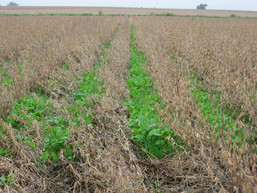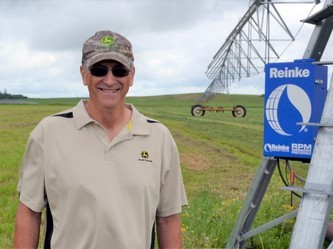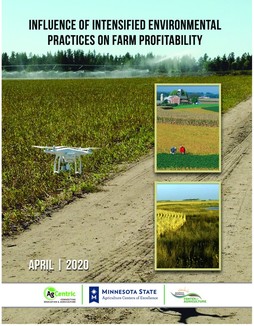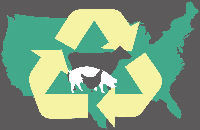
Virtual public information meeting May 6
Lake Pepin in southeast Minnesota is close to meeting its custom water-quality standard designed to minimize algae, with more work needed upstream to meet the goal, according to a study recently released by the Minnesota Pollution Control Agency (MPCA). The study focuses on phosphorus levels in Lake Pepin and the Mississippi River upstream, from the Crow River near Dayton, Minn. to the St. Croix River near Hastings.
Phosphorus comes from many sources, including wastewater discharged by communities and industries, and runoff from farm fields and urban areas. Both urban and agricultural sources need to reduce the phosphorus they send to rivers and eventually Lake Pepin. About two-thirds of the algae in Lake Pepin are produced upstream. As such, the study calls for reducing phosphorus from upstream rivers by 10-50 percent.
Further reductions are needed, namely from nonpoint or non-regulated sources such as cropland. For these sources, the focus will remain on voluntary best management practices (BMPs) that build soil health, reduce runoff and help water quality. For example, cover crops are one practice that helps water quality by keeping soil in place during spring storms (photo above right). Keeping soil in place prevents sediment – and phosphorus – from draining to lakes and river.
The MPCA will hold an informational meeting about the TMDL study May 6 via Webex. For access details, and additional information, visit the study webpage: www.pca.state.mn.us/water/tmdl/lake-pepin-excess-nutrients-tmdl-project. If participating in the May 6 Webex meeting:
- Make sure you have a good internet connection.
- Please plan to log into the meeting at least 10 minutes early to work through any technical difficulties you may encounter.
|

Minnesota farmers markets seeking help to ensure that market vendors and customers are practicing safe and sanitary guidelines during the upcoming market season can apply for the Dept. of Agriculture’s (MDA) new Safe at the Farmers Market Cost Share program. -- MDA webpage news release and photo.
Eligible markets may be reimbursed up to $350 on the purchase a variety of equipment that will help markets comply with the Guidance for Minnesota Farmers Markets and Vendors.
Examples of eligible equipment include handwashing stations, additional tables to increase distance between vendors and customers, signage to properly communicate handwashing and social distancing, sanitation supplies to clean commonly touched surfaces, and fencing to guide customers through markets.
In order to qualify, farmers market must be authorized to participate in SNAP in 2020 and a) be located in or adjacent to a food desert or b) be located in or adjacent to a low-income or moderate-income area and serve a population with limited access, such as the elderly or disabled.
Applications to the program are being accepted now through May 31, 2020, or until all funds are depleted. Funds will be awarded on a first-come, first-served basis. Markets will receive payment approximately two to four weeks after their application is approved.
For more information and to get an application form, visit the MDA’s Safe at the Market Cost Share web page. Funding for this program is made available through the Good Food Access Program.
|

Bob Brauchler hesitates to call himself a conservationist, although he is one, even if it’s only by accident. The farming practices he’s honed over the past 40 years near Paynesville may be focused on his bottom line, but they’re also helping preserve and protect the precious groundwater resources in central Minnesota’s Bonanza Valley area.
While abundant in the area, water conservation is a concern to the Minnesota Department of Natural Resources, because increasing demands put on groundwater may not be sustainable unless steps are taken to more closely manage its use. The DNR worked with area farmers and others to develop the Bonanza Valley Groundwater management plan several years ago. But some farmers like Brauchler are finding that conserving water also saves money. Read more in the DNR Bonanza Valley Groundwater Management Area Update.
|

A new report by the Farm Business Management Program shows greater profitability among farms with enhanced environmental stewardship practices. It compares farms enrolled in the Minnesota Agricultural Water Quality Certification Program to farms overall, and found MAWQCP farms were more profitable, and outperformed other farms in the key elements that achieve higher profitability: Higher net income, lower expenses, and even higher yields. Influence of intensified environmental practices on farm profitability.
"Identifying a cohort to compare to the benchmarks of current practice can be the most difficult part of providing comparison data. For this sort, the cohort has been defined as: Minnesota Water Quality Certified farms that are a part of the MN FBM state database. This first year document is designed to provide a broad overview of selected financial and production factors that provide a “window” into longer term comparisons. It is a “First Look” and not intended to suggest that a long term trend is represented in this report."
|

Minnesota citizens interested in influencing natural resources issues at the local level are encouraged to run for supervisor of their local Soil and Water Conservation District (SWCD).
SWCD supervisor positions are filled through general elections Nov. 3, 2020. Anyone interested in running for Supervisor should file at the County Auditor’s office from May 19, 2020,until June 2, 2020, at 5 p.m.
Supervisors meet monthly to discuss the business of the SWCD, including state grant allocations to landowners, district conservation priorities, and coordination with other local units of government and state and federal agencies. Supervisors do not receive a salary, although they do receive compensation for attending meetings and are reimbursed for expenses.
Contact your local SWCD for more information: SWCD Directory, SWCD websites
|

Livestock and Poultry Environmental Learning Community Webinar May 15
Livestock operations take great care to maintain the health of their animals. Attention to the health of the people working with the livestock should also be a part of the day-to-day operations. Pathogens such as E.Coli 0157:H7, Salmonella, and Listeria can infect humans. Dust, whether from manure, feeding, or field operations can also impact human health. Dust is often overlooked as being just a part of agriculture, but small particulate matter (PM10 and PM2.5) can seriously impact people with respiratory issues. This webinar will provide practical guidance on reducing pathogen and inhalation exposures in livestock operations and identify ways to protect human health and those we love.
May 15 at 1:30 pm. Read more or register for the webinar. Presenters: Dr. Matt Nonnenmann, University of Iowa; Dr. Renee Anthony, University of Iowa; Dr. Michael Pate, Utah State.
|
USDA news release: The U.S. Department of Agriculture’s Farm Service Agency (FSA) will open signup this summer for CLEAR30, a new pilot program that offers farmers and landowners an opportunity to enroll in a 30-year Conservation Reserve Program (CRP) contract. This pilot is available to farmers and landowners with expiring water-quality practice CRP contracts in the Great Lakes and Chesapeake Bay regions. The program signup period is July 6 to Aug. 21, 2020. The longer contracts will help ensure that practices remain in place for 30 years, which will help reduce sediment and nutrient runoff and help prevent algal blooms. Traditional CRP contracts run from 10 to 15 years.
Annual rental payment for landowners who enroll in CLEAR30 will be equal to the current Continuous CRP annual payment rate, plus an inflationary adjustment of 27.5 percent, since CLEAR30 contracts will be for 30 years – much longer than the 10- to 15-year contracts for Continuous CRP offers.Another unique program feature is that FSA will help producers maintain CLEAR30 contract acreage. USDA Service Centers are open for business by phone appointment only. More information can be found at farmers.gov/coronavirus.
Can ‘Carbon Smart’ Farming Play a Key Role in the Climate Fight?, Yale 360.
Aug. 4-6: Farm Fest, Gilfillan Farm, Redwood County.
Postponed to Aug. 25-26, 2021: North American Manure Expo, Listowel, Ontario, Canada.
The
MPCA Feedlot Update welcomes news from partners about, projects, people, and
upcoming events. Email submissions to forrest.peterson@state.mn.us.
Past issues of Feedlot Update are available on the feedlot program publications webpage.
|